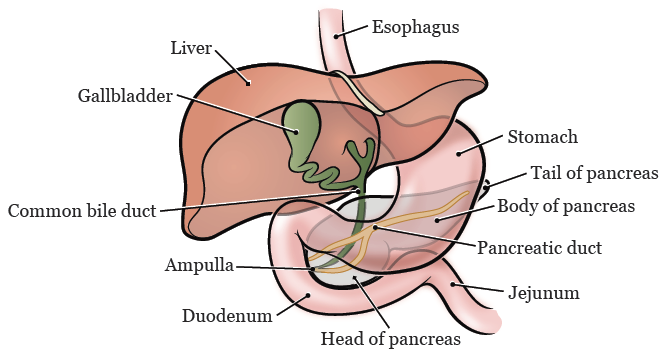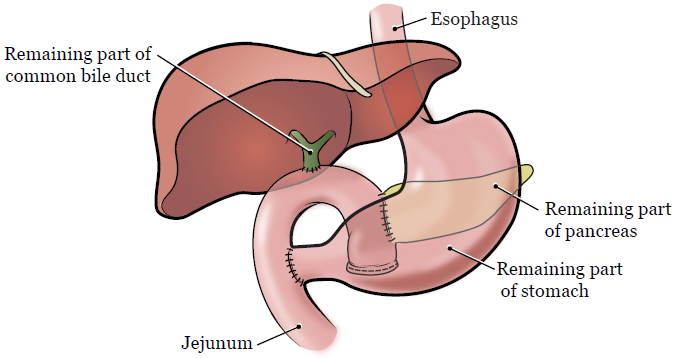This information will help you understand your family member or friend’s Whipple procedure (pancreaticoduodenectomy). Please use it as a reference while you wait during the surgery and when getting updates from your nurse liaison.
The Whipple procedure is a surgery to remove a tumor in the head of the pancreas.
About your organs
Pancreas
The pancreas is an organ located in the back of the abdomen (belly) behind the stomach and just above the small intestine (see Figure 1). It has 3 sections: the head, body, and tail. The head of the pancreas is attached to the duodenum (the first part of the small intestine).
The pancreas has 2 main functions:
- It makes digestive fluids that help break down fats and proteins.
- It makes insulin and glucagon, hormones that help regulate blood sugar levels.
Even though part of the pancreas is removed during surgery, there’s usually enough left to keep making digestive fluids and hormones.
Gallbladder
The gallbladder is a small, tear-drop shaped organ located under the liver. Its main job is to store bile. Bile is a substance made in the liver that helps the body digest fat. When food is eaten, the gallbladder sends stored bile to the duodenum to help with digestion.
Common bile duct
The common bile duct is a small tube. It moves bile from the liver to the gallbladder to be stored, then from the gallbladder into the duodenum.
Duodenum
The duodenum is the first part of the small intestine. It’s directly attached to the stomach. Partially digested food moves from the stomach into the duodenum, where it’s further digested by bile from the gallbladder and digestive fluids from the pancreas.
Jejunum
The jejunum is the middle part of the small intestine, where the digestive process continues.

Figure 1. The pancreas and surrounding organs
About the Whipple procedure
The Whipple procedure is done using one large incision (surgical cut) in the abdomen. Sometimes, before making the large incision, the surgeon will make several small incisions and put a small video camera into the abdomen. They use this camera to look at the organs to see if the cancer has spread outside of the pancreas. This is called a diagnostic laparoscopy (a minimally invasive procedure). If the cancer has spread, the surgeon may decide not to continue with the surgery. If the cancer hasn’t spread, the surgeon will make a large incision and continue with the Whipple procedure to try to remove the tumor.
During the surgery, the surgeon will remove the gallbladder, the head of the pancreas, the duodenum, and the end of the common bile duct. Sometimes, part of the stomach must be removed.
Then, the surgeon will connect the rest of the common bile duct, the remaining pancreas (the tail), and the stomach to the jejunum. This is so the pancreatic fluids and bile will flow into the small intestine, as before (see Figure 2).

Figure 2. The pancreas and surrounding organs after surgery
Once the patient is checked in, they will go to the Presurgical Unit to be examined before surgery.
Sometimes, surgeries are delayed. This could happen if an earlier surgery takes longer than expected or for other reasons beyond our control. We will make every effort to notify you if that happens.
When the operating room (OR) is ready, the surgical team will take the patient there. They will get the patient ready for surgery, which can take 15 to 90 minutes.
The nurse liaison role
The nurse liaison will call you every 2 hours with updates.
Sometimes, the surgeon will need to speak with the patient’s family and friends during the surgery to talk about what they see during surgery. If this happens, the nurse liaison will be there for the conversation.
Please contact the nurse liaison if a problem comes up or if you just need to talk. To reach your nurse liaison:
- From outside of the hospital, dial 212-639-2000. Ask for beeper 9000.
- Ask a staff member at the front desk to contact the nurse liaison for you.
During the surgery
The surgery usually takes about 4 hours, but the time may vary. You will be updated throughout the procedure.
The nurse liaisons will continue to update you on the progress of the surgery by phone.
After the surgery
A team member will contact you by phone when the surgery is almost finished.
The surgeon will explain what was found during the surgery and you will be able to ask questions.
After surgery, the patient will be taken to the PACU.
The patient may be tired, groggy, or uncomfortable after their surgery. They will be getting oxygen through a thin tube that rests beneath their nose. They may also be connected to other tubes and wires, such as an intravenous (IV) line to give them pain medication and a pulse oximeter to measure their oxygen level and heart rate.
The PACU nurse will explain the plan of care for the patient, such as whether the patient is staying overnight and when they will be moved to an inpatient room.
We will give you a card with the PACU phone number. Please choose just one person to call for updates.
More resources
Information for Family and Friends for the Day of Surgery
Pancreatic Cancer Action Network
www.pancan.org
877-573-9971
A national patient advocacy organization for the pancreatic cancer community. This organization helps patients and caregivers find information about pancreatic cancer, clinical trials, and support resources. It also has a survivor and caregiver support network.
